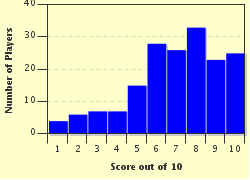Quiz Answer Key and Fun Facts
1. Some people have thought that Inuit languages have more words for snow than other languages. In "Miss Smilla's Feeling for Snow" the lead character from Greenland has a great understanding of different types of snow which proves to be important in helping to investigate a mysterious death. Which Danish author wrote this crime novel?
2. Who was the Scottish author of "A Study in Scarlet" - one of only four full-length novels in a series of stories featuring the same characters?
3. With this next novel you might be forgiven for thinking Sherlock Holmes has wandered into medieval Italy and joined a monastery. "The Name of the Rose" was a novel made into a film starring Sean Connery. Who wrote it?
4. Who is the Sri Lankan-born Canadian writer who won The Booker Prize for his novel "The English Patient" which was made into a film starring Ralph Fiennes?
5. Which book by George Orwell was written about a war?
6. This man is known for writing the first authoritative "Dictionary of the English Language" and for his literary criticism and his wit. He had a "fan" who became his friend and biographer. Name him.
7. Which Irish author, who wrote in a style of absurdist humour, produced books entitled "The Third Policeman","The Poor Mouth", "The Dalkey Archive" and "At Swim Two Birds"? He also wrote a column for the Irish Times under the pen name Myles na Gopaleen.
8. Which classical Roman poet famously wrote a series of "Odes" that inspired or were admired by English writers William Shakespeare, John Dryden, Andrew Marvell, and Samuel Johnson among others?
9. Set in the Napoleonic era, "The Count of Monte Cristo" is an epic tale of the betrayal, imprisonment and elaborate revenge of Edmond Dantes. Who wrote this book?
10. It's been more or less the norm for a medieval monarch to have "rubbed out" some inconvenient or problematic person in their way. Most historians accept that the following Kings were murderous in their time. Which one featured in the title of a play by Shakespeare?
Source: Author
Mixamatosis
This quiz was reviewed by FunTrivia editor
agony before going online.
Any errors found in FunTrivia content are routinely corrected through our feedback system.


